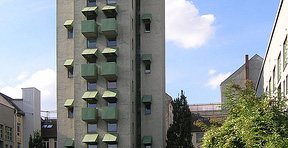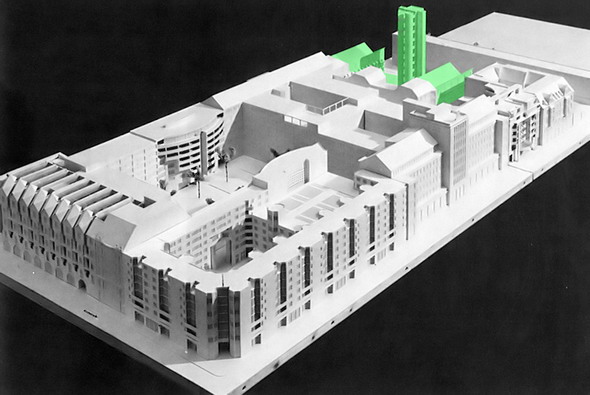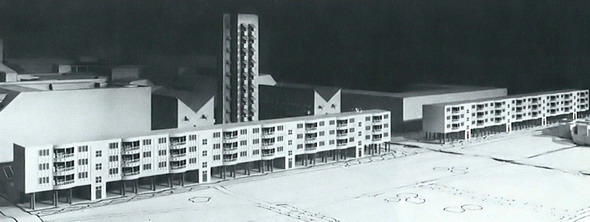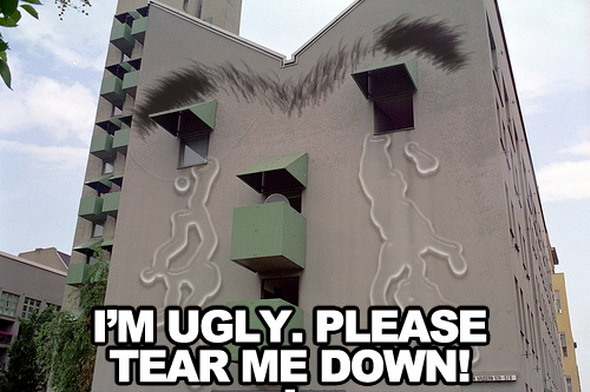
Depuis quelques jours ( sujet écrit en mars 2010), la communauté architecturale internationale se passionne pour sauver d’une rénovation jugée outrancière un projet de l’architecte américain John Hejduk: l’opération de logement situé a Berlin, au 96-98 sur CharlottenstraBe ( Kreuzberg). Une pétition en ligne est activée et le débat fait rage, certains considérant le bâtiment hideux, d’autre une oeuvre majeure d’architecture. Ce sujet mérite donc d’être abordé en francais pour que chacun se fasse une opinion. ( MAJ: janvier 2012: le projet est sauvé..le promoteur Berlinois rénove le projet à l’identique…)
La pétition( +2500 signatures au 29 mars 2010) Texte francais sous la traduction anglaise English translation of the french text below: ( done in a hurry > excuse the english!)
International architectural world was passionated about the refurbishing of a project by american architect John Hejduk, located in Berlin.Online surveys, petitions and debates had been firing in order to save the housing IBA project. Some considering it a masterpiece, and other an ugly piece of post modern test…this is the translated version of the article that was written in 2010 following the rage around the new project. It seems the original building was finally saved by the activists!
It is important to replace Hedjuk’s project first in the context of Hejduk’s personality, then in the context of the project.
John Hejduk is an american architect ( see wikipedia link) that has build very few buildings, but has had a major influence on the US architecture academic thinking, especially in Cooper Union where he was teaching and managed pedagogy.
The very surprising and particular pedagogy ( some called it dictatorial) was very different from lets say european or the french teaching of the late 80’s/early 90’s. Having visited CU in 1992 and having discussed with a few students during the » deconstructivist » years of CU, I was very surprised to see projects based on virtual concepts, poetry, the shape of a violin or other means of justification of a project that were thousands of miles away from the contextual approach we were beeing taught then in Paris…( only a few architects like Alain Pelissier in Tolbiac was using the same tools).
Hejduk is also known for his poetic writings that are very difficult to understand for a cartesian mind like me, and the very beautiful wood work/sculpture/architecture? that were beeing build at Georgia Tech ( the mother, the son, the suicidal house…), kind of hairy cabins around which was constructed a complex freudian fable, unreachable by most…I wonder what architecture those now turned architects are building 20 years after that experience.
Hejduk was undoubtly an important theory plastician of american architecture, and his teaching was also of first importance. I would compare the serious matter of it to that of Uno Group pedagogy that was conducted in Paris with the Henri Ciriani team ( very different approach based on the continuum spatial and corbuseesque influence..)….Understanding the message of Hejduk is however very difficult when it comes to real life projects using it…rare are the examples, but Berlin’s project is one.
The project is an important milestone in the IBA projects ( 1987 Berlin masterplan with many invited architects) that mainly targeted Kreuzberg. The Hedjuk project is located south of Checkpoint Charlie, and ends a block toward a park / waste ground. Specifications is for a 14 artists studio tower, and 50 flats. The answer is contextualist to some extend by stitching with nearby existing buildings, anthropomorphist on the south facades, and brutalist in the way it manages the sun protections on balconies and loggias.
The grey paint and the « feldgrau » steel frames and shades give the whole an austere and relatively sad feel that is saved by the quasi maniacal precision of the details and calepinage of the facades. Taken over by private investors, the Berlin project was about to get refurbished and the steel elements of the facades modified ( for a more » friendly » look)….the combat started by Hejduk’s own daughter with the help of international community of architects to have the project untouched or refurbished without modification has finally been won after a massive communication campaign fought over the internet and on site..
Strangely enough, the defense was not really targeted at the own qualities of the building, but more target at the legacy of Hejduk’s work that had to be defended.
This was to my opinion not the best defence ( it worked…so) for different reasons:
First of all, the work of Hejduk is highly theorical and not universal, difficult to understand..esoterical and sometimes a bit hazy…and as such is polemical.
Hejduk was also controversial as a person, massive self-centered teacher for his detractors or pure genius capable of moving moutains with his followers…..
It is more toward the building, l' »Oeuvre » that one should concentrate, and try to extract the qualities and flaws to see if it worth fighting for… Anthropomorphic under some angles, rationalist, powerful by its simplicity, radical, minimalist and masterized that handles nicely the stitching with the existing » bombing » survivors of the block ( contextualist in that way).
It is a diehard project that is a witness of the last hand drawns projects, interesting response from the passionating IBA experience, and those reasons are enough for wanting to save the building..not the fact that its a « Hejduk »…
It finally raises a question: What is the margin of authorized modifications that we can allow on a project without transforming its core spirit, and how cities and needs can evolve around a non evoluating building, where the specifications is so tight that it cannot be modified ( 4sqm rooms will never be a bedroom for children…).
Version Francaise:
Il est important de replacer le projet de Hejduk dans le contexte, de la personnalité de Hejduk tout d’abord, puis du contexte de l’affaire de ce projet. John Hejduk est un architecte américain ( voir wikipédia) qui a très peu construit mais énormément influencé aux états-unis la pensée universitaire de l’enseignement de l’architecture, en particulier à Cooper Union ( NYC) ou il enseignait et dirigeait la pédagogie. Sa pédagogie très particulière ( certains la qualifient de dictatoriale) assez surprenante et très éloignée de l’enseignement de l’architecture que nous connaissons en France par exemple. Ayant visité Cooper Union en 1992 lors d’un voyage d’étude, j’ai pu visiter les ateliers et discuter avec des étudiants ( en pleine période déconstructiviste ) et nous avions été surpris de voir des projets basés uniquement sur l’analyse d’un poème, la forme d’un stradivarius, ou bien encore d’autre moyen de justification de projet très éloigné de l’approche contextualiste qui nous était enseignée alors ( Seul Alain Pélissier à Tolbiac bâtissait son enseignement sur des voies similaires il me semble..).
Hejduk est connu pour ses écrits poétiques et difficiles à comprendre avec un regard cartésien ( ou en tous cas pour moi!) et les magnifiques réalisations en bois fabriquées dans les ateliers de l’école Georgia Tech ( la mère, le fils, les maisons du suicide…sortes de cabanes hirsutes autour desquels Hejduk bâti un conte psychologique freudien complexe) sont difficiles à appréhender
Il s’agit donc d’un théoricien plasticien important de l’architecture américaine pour qui l’enseignement était un acte important, en france j’imagine qu’on pourrait comparer la rigueur et la volonté de son enseignement à celle d’Uno de l’équipe Ciriani, même si la compréhension du message est difficile une fois rapporté a l’acte de concevoir un vrai projet Le projet pour résumer est un des résultat de l’important projet urbain IBA ( Internationalle Baaustellung ), qui visait a rénover intégralement le centre de Berlin ouest, en particulier du quartier Kreuzberg.
Le projet de Hedjuk, situé juste au sud de Checkpoint Charlie, vient terminer un ilôt en bordure d’un parc. Le programme est une tour de 14 ateliers d’artistes, et 50 logements. La réponse est contextualiste dans son raccord avec l’existant, anthropomorphique pour le traitement des pignons, et presque brutaliste dans son traitement des loggias et protections sur la cour. Un enduit gris et des menuiseries laquées vertes « feldgrau » donnent à l’ensemble une austérité et une certaine tristesse que vient sauver une maitrise presque maniaque des calepinages et détails d’exécution.
Repris par des promoteurs qui réalisent un gros rafraîssement du bâtiment, et une modification des appendices de façade, le projet est sujet d’une vaste tentative de défense de son intégrité, lancé par la fille de Hejduk, relayé par des architectes Berlinois. Les arguments principaux sont paradoxalement plutôt liés à l’oeuvre de Hejduk plutôt que dans la défense du projet par ses qualités intrinsèques. Ce qui est justement étrange et a mon avis pas forcément la bonne défense. Tout d’abord parce que l’oeuvre de Hejduk est principalement une oeuvre théorique, mais a mon avis aussi parce qu’elle est méconnue, non universelle, difficile d’accès ( un peu ésotérique / fumeux a mon idée)…et qu’elle est donc sujet à polémique.
Le personnage Hejduk est lui aussi controversé: despote a l’égo démesuré comme enseignant en archi pour ses détracteurs ou pur génie façon prof du cercle des poètes disparus selon d’autres.
C’est donc plutôt a mon avis du coté du bâtiment que l’intérêt doit se porter: anthropomorphe sous certains angles, rationaliste sous d’autres, puissant de simplicité, radical, calepiné et maîtrisé qui apporte une réponse intelligente au site, en couture avec l’ilôt survivant des bombardements ( contextualiste donc à cet égard)..C’est un projet jusqu’au boutiste, témoignage intéressant des derniers projets entièrement dessinés à la main, fruit de l’énorme travail passionnant de l’IBA, et ces raisons poussent a vouloir défendre le projet.
La question qui reste est finalement: que peut on modifier sans déprécier l’homogénéité d’un projet, et surtout comment l’histoire de la ville et les besoins peuvent évoluer avec un bâtiment non évolutif, et au programme si canalisé ( la tour est destiné a des ateliers d’artiste, pas du logement ( les pièces attenantes de 4m2 ne sont pas et ne seront jamais des chambres!).. Pour suivre ( en anglais) une partie de l’histoire, avec des explications très intéressantes sur la pédagogie Hejduk / Team Five par des anciens étudiants : ICI



source: www.archinect.com